2015 TOYOTA AYGO fuel cap
[x] Cancel search: fuel capPage 3 of 440

3
1
7
8
6
5
4
3
2
9
AYGO_EE_OM99J92E
4-2. Driving procedures
Engine (ignition) switch
(vehicles without a smart
entry & start system)........151
Engine (ignition) switch
(vehicles with a smart
entry & start system)........154
Multi-mode manual
transmission ....................159
Manual transmission ..........163
Turn signal lever ................165
Parking brake.....................166
4-3. Operating the lights
and wipers
Headlight switch.................167
Fog light switch ..................171
Windshield wiper
and washer ......................173
Rear window wiper
and washer ......................175
4-4. Refueling
Opening the fuel tank
cap ...................................177
4-5. Using the driving support
systems
Speed limiter ......................181
Stop & Start system ...........185
Driving assist systems .......191
4-6. Driving tips
Winter driving tips ..............196
5-1. Basic Operations
Audio system types ........... 200
Steering wheel audio
switches .......................... 202
AUX port/USB port ............ 203
5-2. Using the audio system
Optimal use of the
audio system ................... 204
5-3. Using the radio
Radio operation ................. 206
5-4. Using an external device
Listening to an iPod........... 211
Listening USB memory
device.............................. 219
Using the AUX port ........... 226
5-5. Using Bluetooth® devices
Bluetooth® audio/phone .... 227
Using the steering
wheel switches ................ 233
Registering a
Bluetooth® device ........... 234
5-6. “SETUP” menu
Using the “SETUP” menu
(“Bluetooth*” menu)......... 235
Using the “SETUP” menu
(“TEL” menu)................... 239
5-7. Bluetooth® Audio
Operating a Bluetooth®
enabled portable
player .............................. 242
5Audio system
*: Bluetooth is a registered trademark of Bluetooth SIG, Inc.
Page 11 of 440

11Pictorial index
AYGO_EE_OM99J92E
Windshield wiper . . . . . . . . . . . . . . . . . . . . . . . . . . . . . . . . . . P. 173
Precautions against winter season . . . . . . . . . . . . . . . . . . . . . P. 196
Fuel filler door . . . . . . . . . . . . . . . . . . . . . . . . . . . . . . . . . . . . P. 177
Refueling method . . . . . . . . . . . . . . . . . . . . . . . . . . . . . . . . . . P. 177
Fuel type/fuel tank capacity . . . . . . . . . . . . . . . . . . . . . . . . . . . P. 408
Tires . . . . . . . . . . . . . . . . . . . . . . . . . . . . . . . . . . . . . . . . . . . . P. 308
Tire size/inflation pressure . . . . . . . . . . . . . . . . . . . . . . . . . . . . P. 416
Winter tires/tire chain . . . . . . . . . . . . . . . . . . . . . . . . . . . . . . . . P. 196
Checking/rotation/tire pressure warning system*2 . . . . . . . . . P. 308
Coping with flat tires . . . . . . . . . . . . . . . . . . . . . . . . . . . . P. 361, 374
Hood . . . . . . . . . . . . . . . . . . . . . . . . . . . . . . . . . . . . . . . . . . . . P. 293
Opening . . . . . . . . . . . . . . . . . . . . . . . . . . . . . . . . . . . . . . . . . . P. 293
Engine oil . . . . . . . . . . . . . . . . . . . . . . . . . . . . . . . . . . . . . . . . . P. 408
Coping with overheat . . . . . . . . . . . . . . . . . . . . . . . . . . . . . . . . P. 398
Camera*2, 3
Headlights . . . . . . . . . . . . . . . . . . . . . . . . . . . . . . . . . . . . . . . P. 167
Front position lights . . . . . . . . . . . . . . . . . . . . . . . . . . . . . . . P. 167
Daytime running lights*2 . . . . . . . . . . . . . . . . . . . . . . . . . . . P. 167
Front fog lights*2/rear fog lights . . . . . . . . . . . . . . . . . . . . . P. 171
Turn signal lights . . . . . . . . . . . . . . . . . . . . . . . . . . . . . . . . . . P. 165
Emergency brake signal . . . . . . . . . . . . . . . . . . . . . . . . . . . . . P. 191
Tail lights . . . . . . . . . . . . . . . . . . . . . . . . . . . . . . . . . . . . . . . . P. 167
License plate lights . . . . . . . . . . . . . . . . . . . . . . . . . . . . . . . . P. 167
Back-up lights
Shifting the shift lever to R. . . . . . . . . . . . . . . . . . . . . . . . P. 159, 163
4
5
6
7
8
Light bulbs of the exterior lights for driving
(Replacing method: P. 330, Watts: P. 418)
*1: Vehicles with a smart entry & start system
*2: If equipped
*3: For vehicles with a multimedia system , refer to “Multimedia owner’s manual”.
9
10
11
12
13
14
15
16
Page 139 of 440

139
4Driving
AYGO_EE_OM99J92E
4-1. Before driving
Driving the vehicle ............. 140
Cargo and luggage ............ 149
Trailer towing ..................... 150
4-2. Driving procedures
Engine (ignition) switch
(vehicles without a smart
entry & start system)........ 151
Engine (ignition) switch
(vehicles with a smart
entry & start system)........ 154
Multi-mode manual
transmission .................... 159
Manual transmission.......... 163
Turn signal lever ................ 165
Parking brake .................... 166
4-3. Operating the lights
and wipers
Headlight switch................. 167
Fog light switch .................. 171
Windshield wiper
and washer ...................... 173
Rear window wiper
and washer ...................... 175
4-4. Refueling
Opening the fuel tank
cap ................................... 177
4-5. Using the driving support
systems
Speed limiter ...................... 181
Stop & Start system ........... 185
Driving assist systems ....... 191
4-6. Driving tips
Winter driving tips .............. 196
Page 177 of 440
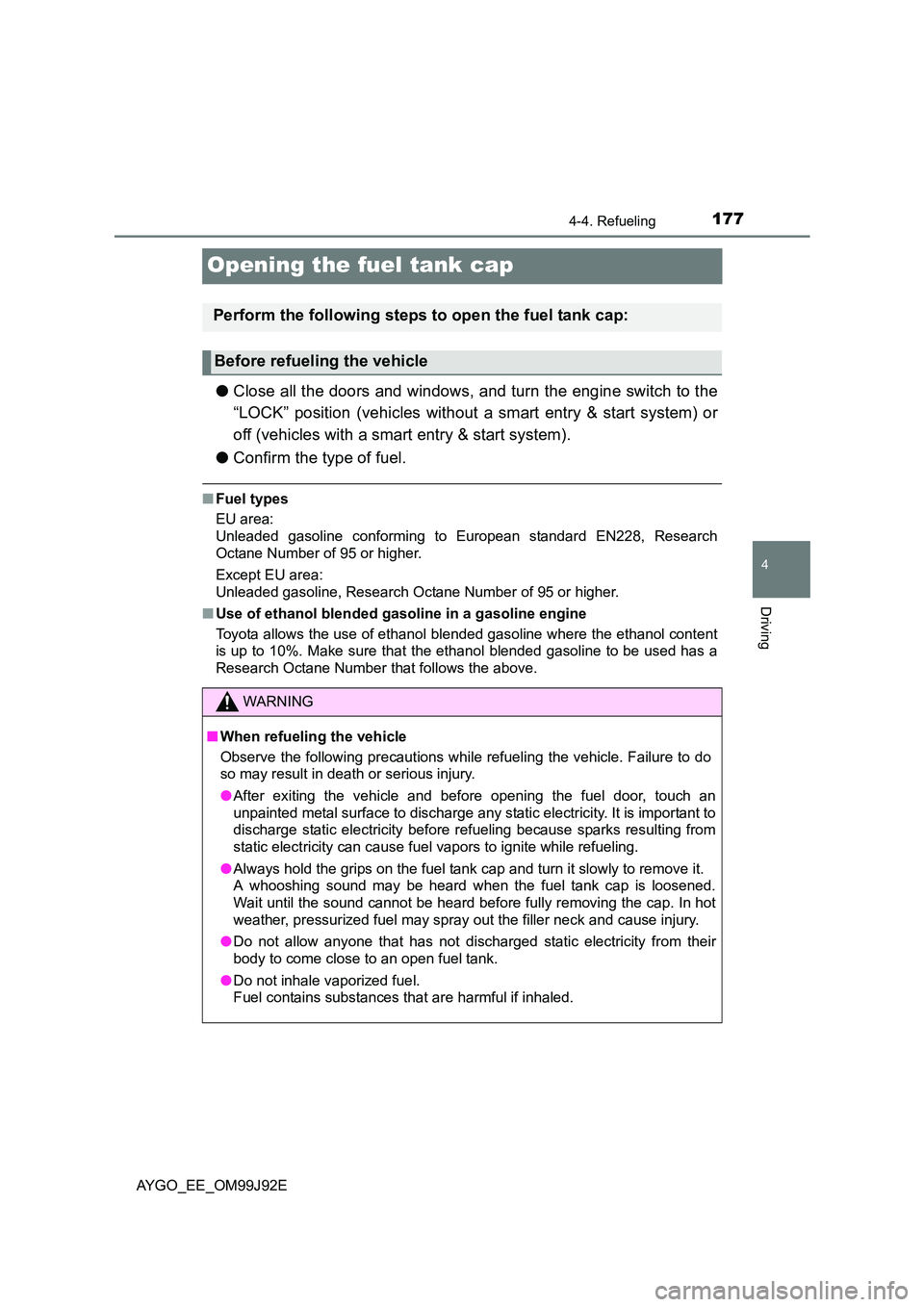
177
4
4-4. Refueling
Driving
AYGO_EE_OM99J92E
Opening the fuel tank cap
●Close all the doors and windows, and turn the engine switch to the
“LOCK” position (vehicles without a smart entry & start system) or
off (vehicles with a smart entry & start system).
● Confirm the type of fuel.
■Fuel types
EU area:
Unleaded gasoline conforming to European standard EN228, Research
Octane Number of 95 or higher.
Except EU area:
Unleaded gasoline, Research Octane Number of 95 or higher.
■ Use of ethanol blended gasoline in a gasoline engine
Toyota allows the use of ethanol blended gasoline where the ethanol content
is up to 10%. Make sure that the ethanol blended gasoline to be used has a
Research Octane Number that follows the above.
Perform the following steps to open the fuel tank cap:
Before refueling the vehicle
WARNING
■ When refueling the vehicle
Observe the following precautions while refueling the vehicle. Failure to do
so may result in death or serious injury.
● After exiting the vehicle and before opening the fuel door, touch an
unpainted metal surface to discharge any static electricity. It is important to
discharge static electricity before refueling because sparks resulting from
static electricity can cause fuel vapors to ignite while refueling.
● Always hold the grips on the fuel tank cap and turn it slowly to remove it.
A whooshing sound may be heard when the fuel tank cap is loosened.
Wait until the sound cannot be heard before fully removing the cap. In hot
weather, pressurized fuel may spray out the filler neck and cause injury.
● Do not allow anyone that has not discharged static electricity from their
body to come close to an open fuel tank.
● Do not inhale vaporized fuel.
Fuel contains substances that are harmful if inhaled.
Page 179 of 440
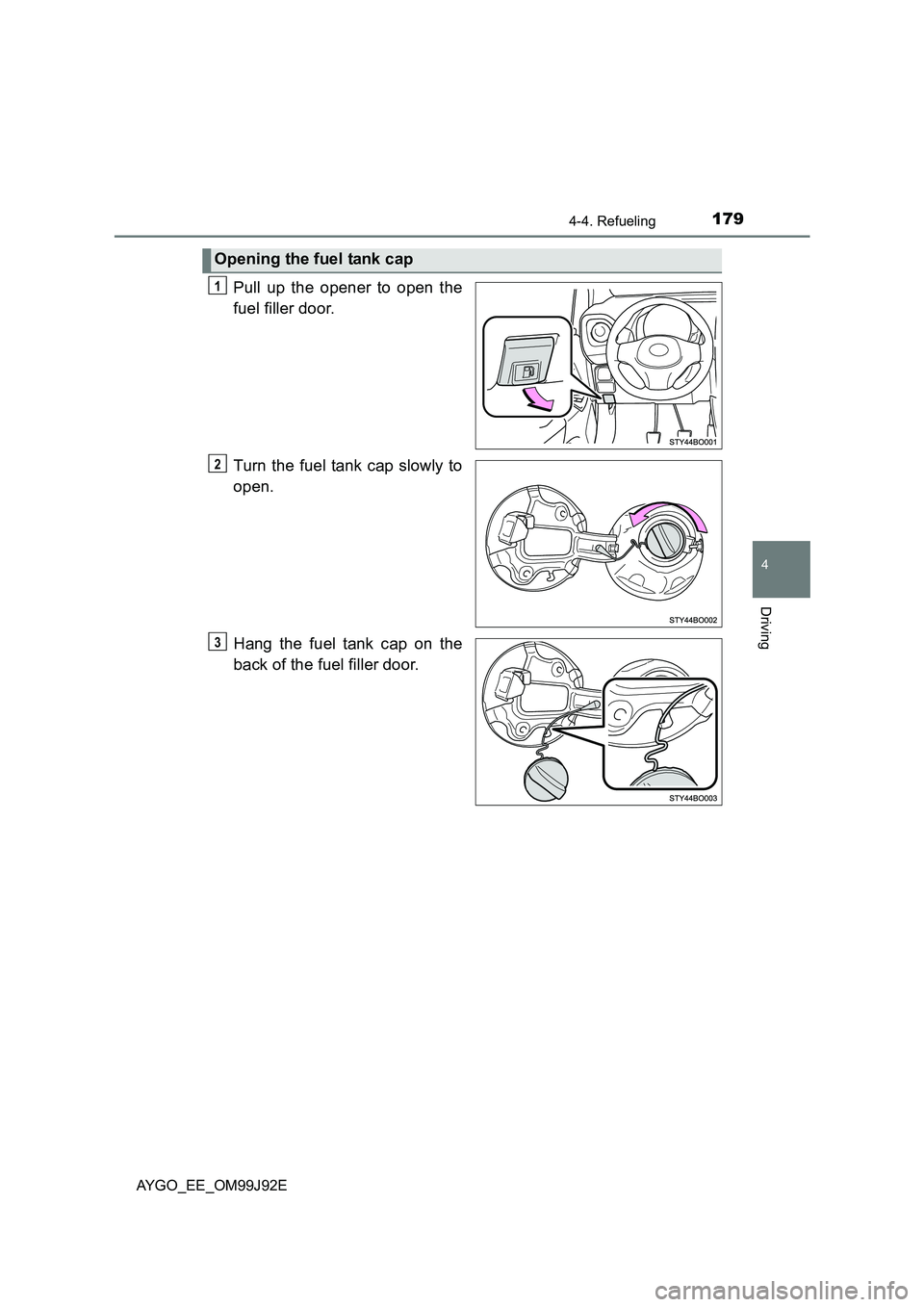
1794-4. Refueling
4
Driving
AYGO_EE_OM99J92E
Pull up the opener to open the
fuel filler door.
Turn the fuel tank cap slowly to
open.
Hang the fuel tank cap on the
back of the fuel filler door.
Opening the fuel tank cap
1
2
3
Page 180 of 440
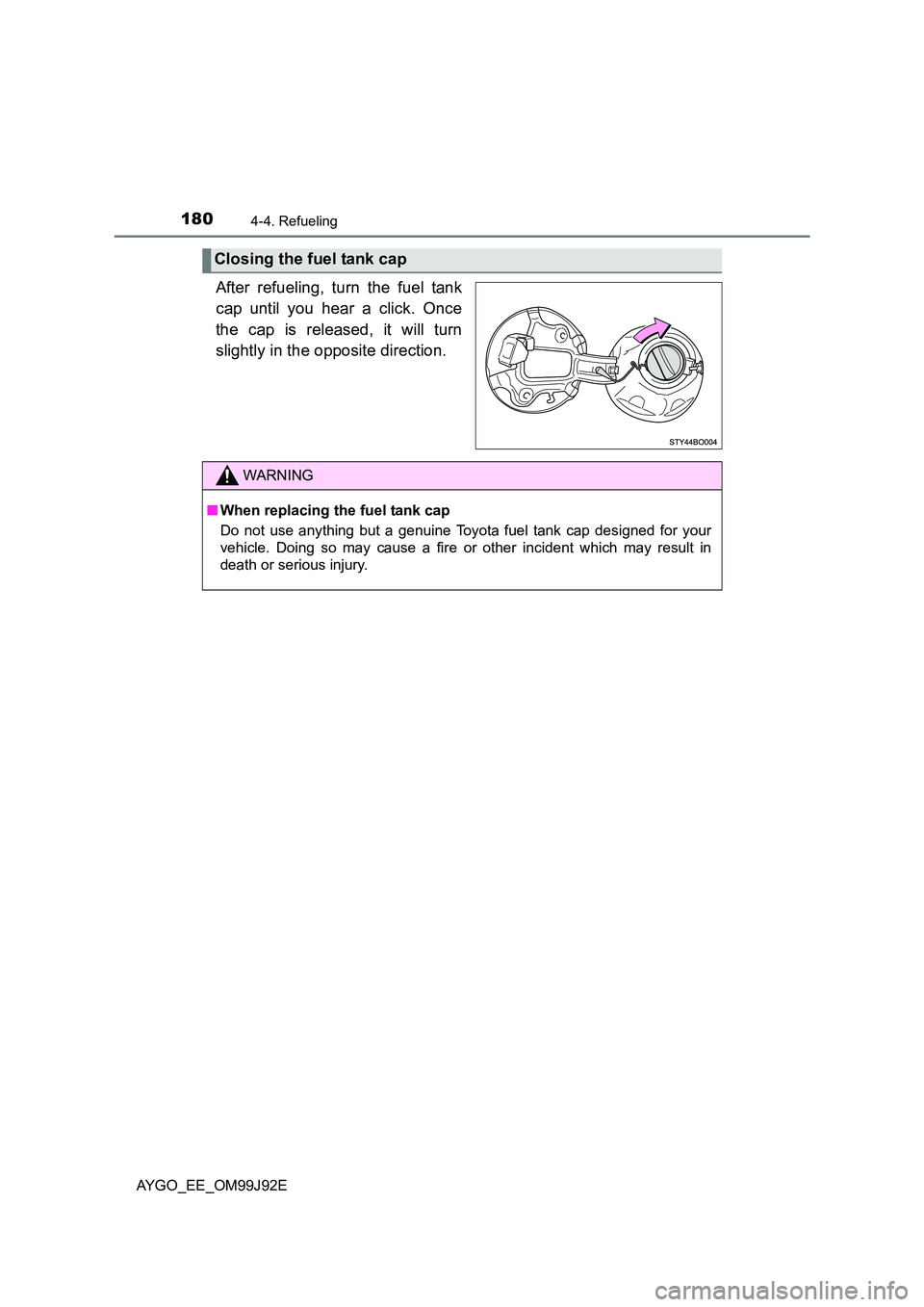
1804-4. Refueling
AYGO_EE_OM99J92E
After refueling, turn the fuel tank
cap until you hear a click. Once
the cap is released, it will turn
slightly in the opposite direction.
Closing the fuel tank cap
WARNING
■ When replacing the fuel tank cap
Do not use anything but a genuine Toyota fuel tank cap designed for your
vehicle. Doing so may cause a fire or other incident which may result in
death or serious injury.
Page 314 of 440
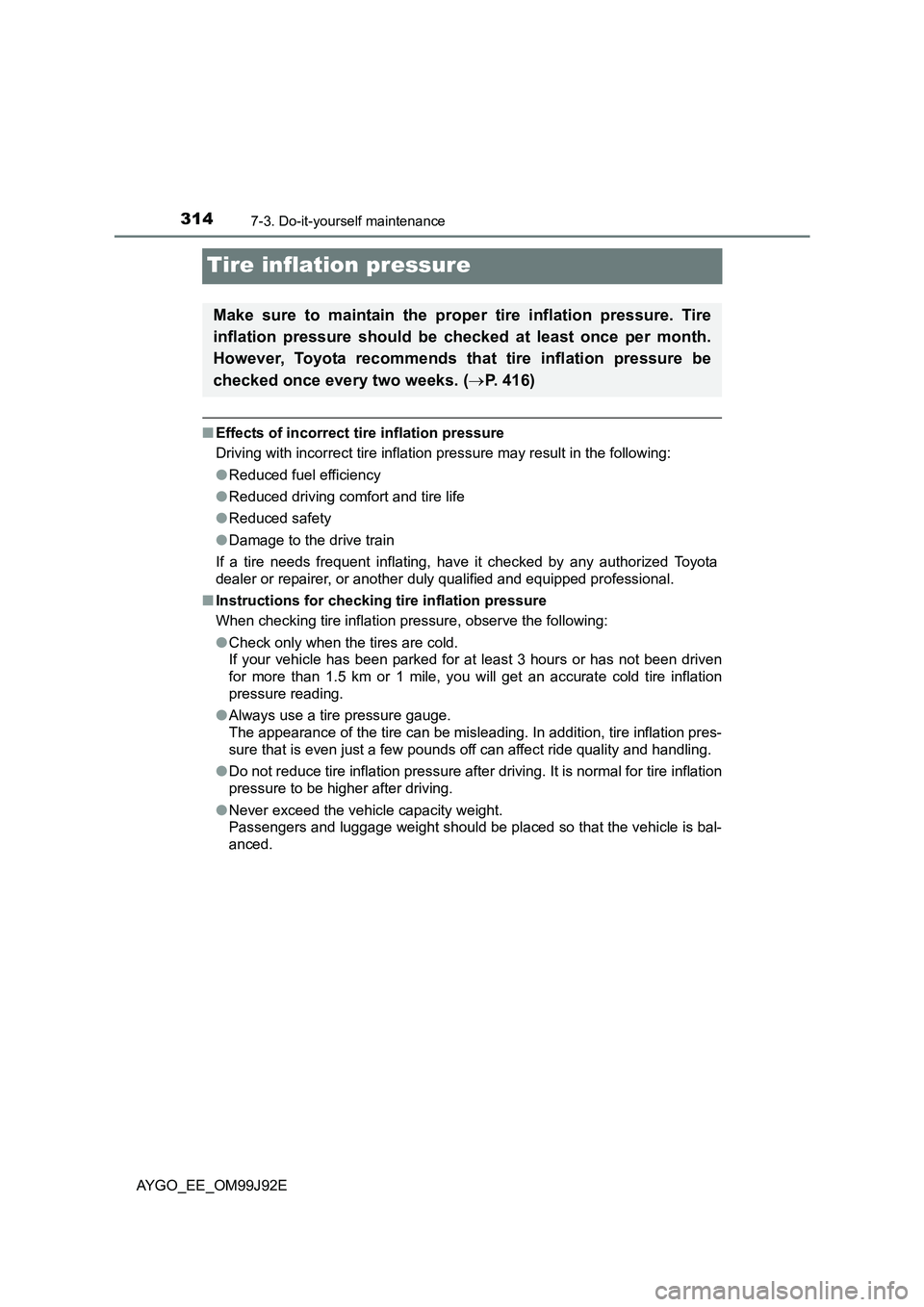
3147-3. Do-it-yourself maintenance
AYGO_EE_OM99J92E
Tire inflation pressure
■Effects of incorrect tire inflation pressure
Driving with incorrect tire inflation pressure may result in the following:
● Reduced fuel efficiency
● Reduced driving comfort and tire life
● Reduced safety
● Damage to the drive train
If a tire needs frequent inflating, have it checked by any authorized Toyota
dealer or repairer, or another duly qualified and equipped professional.
■ Instructions for checking tire inflation pressure
When checking tire inflation pressure, observe the following:
● Check only when the tires are cold.
If your vehicle has been parked for at least 3 hours or has not been driven
for more than 1.5 km or 1 mile, you will get an accurate cold tire inflation
pressure reading.
● Always use a tire pressure gauge.
The appearance of the tire can be misleading . In addition, tire inflation pres-
sure that is even just a few pounds off can affect ride quality and handling.
● Do not reduce tire inflation pressure after driving. It is normal for tire inflation
pressure to be higher after driving.
● Never exceed the vehicle capacity weight.
Passengers and luggage weight should be placed so that the vehicle is bal-
anced.
Make sure to maintain the proper tire inflation pressure. Tire
inflation pressure should be checked at least once per month.
However, Toyota recommends that tire inflation pressure be
checked once every two weeks. ( →P. 416)
Page 406 of 440
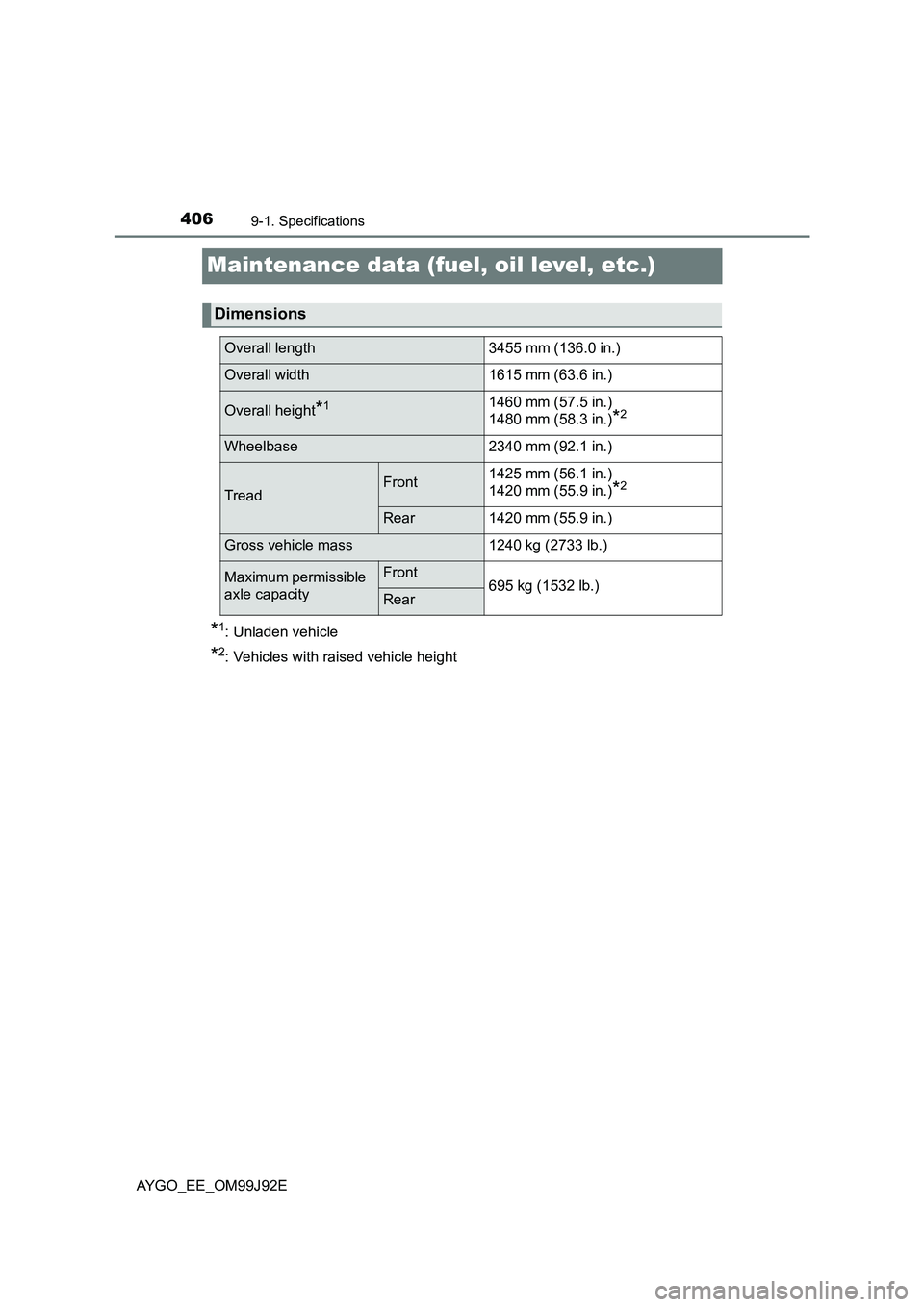
4069-1. Specifications
AYGO_EE_OM99J92E
Maintenance data (fuel, oil level, etc.)
*1: Unladen vehicle
*2: Vehicles with raised vehicle height
Dimensions
Overall length3455 mm (136.0 in.)
Overall width1615 mm (63.6 in.)
Overall height*11460 mm (57.5 in.)
1480 mm (58.3 in.)*2
Wheelbase2340 mm (92.1 in.)
TreadFront1425 mm (56.1 in.)
1420 mm (55.9 in.)*2
Rear1420 mm (55.9 in.)
Gross vehicle mass1240 kg (2733 lb.)
Maximum permissible
axle capacity
Front695 kg (1532 lb.)Rear